Optimization of Ecological Water Supplement Scheme for Improved Suitable Habitat Area for Rare Migratory Birds in Nature Reserves Using Interval-Parameter Fuzzy Two-Stage Stochastic Programming Model
Abstract
1. Introduction
2. Materials and Methods
2.1. Objective Function and Constraints of Interval-Parameter Fuzzy Two-Stage Stochastic Programming Model
- (1)
- The constraint for the maximization of the recovered habitat area is presented below:where i represents the lakes in MNNR; denotes the relationship coefficient between the suitable habitat area and the water volume of lake i (ha/104 m3); is an output parameter of model, denoting the optimal water supply target for lake i (104 m3); h represents the flood flow scenario; represents the scenario probability for scenario h, and represents the water shortage in the case of lake i under scenario h (104 m3). and represent the upper and lower bound values of the recovered habitat area obtained from the IPTSP model in a previous study [10] (103 ha).
- (2)
- The constraint for minimum water demand is as follows:where j denotes the ecological function region, and represent the fish pond, crab pond, reed, and marsh wetland, respectively; is a fuzzy variable representing the lower boundary of the function region of lake (103 ha); and represents the water demand per unit area for the function region j of lake (104 m3/103 ha).
- (3)
- The constraints for water supply capacity are as follows [10]:where , and are output parameters of model, representing the local water supply, normal water supply, and the flood resource supply of lake i under scenario h, respectively (104 m3); denotes loss of water supply (104 m3); n represents the water intakes in MNNR; represents the available flood resources of water intake i under scenario h (104 m3); and represent the local water supply and the normal water supply (104 m3) [10].
- (4)
- The constraints for water supplement sequence in different ecological function regions are as follows:where denotes the area of the ecological function region j of lake i (103 ha). The constraints reflect that, in the project recommendation scheme, the fish and crab ponds are prioritized over the reed and marsh wetlands, while reed wetlands are prioritized over the marsh wetlands.
- (5)
- The constraints for the area of ecological function regions are presented below:where is a fuzzy variable representing the total planning area of lake i (103 ha), while is the fuzzy variable representing the upper boundary of the ecological function region j of lake i (103 ha).
- (6)
- The constraint for the ecological benefits is presented below [10]:where k represents ecological service functions of MNNR; is a 0–1 variable; represents the benefit per unit area of the ecological service function k of ecological function region j (106 CNY/103 ha); represents the ecological benefits of ecological service function k generated by the project recommendation scheme (106 CNY) [10].
- (7)
2.2. Parameters and Solution of Interval-Parameter Fuzzy Two-Stage Stochastic Programming (IPFTSP) Model
3. Case Study
4. Results and Discussion
4.1. Analysis of the Optimization of Ecological Water Supplement Scheme
4.1.1. Analysis of the Optimization of Ecological Water Supplement Scheme Using Interval-Parameter Fuzzy Two-Stage Stochastic Programming (IPFTSP) Model
4.1.2. Comparison of the Optimization of Ecological Water Supplement Scheme between IPFTSP and IPTSP Models
4.2. Analysis of Habitat Area and Carrying Capacity for Rare Migratory Water Birds Recovered Using Ecological Water Supplement Scheme Optimization under Different Flood Flow Scenarios
4.2.1. Analysis of Habitat Area Recovered Using IPFTSP Model
4.2.2. Analysis of Carrying Capacity Recovered Using IPFTSP Model
4.2.3. Comparison of Recovered Habitat Area and Carrying Capacity between IPFTSP and IPTSP Models
4.3. Analysis of the Area of Lake and Wetland Recovered Using Ecological Water Supplement Scheme Optimization under Different Scenarios
4.3.1. Analysis of the Area of Lake and Wetland Recovered Using IPFTSP Model
4.3.2. Comparison of the Recovered Area of Lake and Wetland between IPFTSP and IPTSP Models
4.4. Calculation of Ecological Service Value and Net Carbon Sink Generated by the Ecological Function Region Recovered through Multiple Water Supplement Schemes under Different Flood Flow Scenarios
5. Conclusions
Author Contributions
Funding
Acknowledgments
Conflicts of Interest
References
- Yan, F.Q.; Zhang, S.W. Ecosystem service decline in response to wetland loss in the Sanjiang Plain, Northeast China. Ecol. Eng. 2019, 130, 117–121. [Google Scholar] [CrossRef]
- Langan, C.; Farmer, J.; Rivington, M.; Novo, P.; Smith, J.O. A wetland ecosystem service assessment tool; Development and application in a tropical peatland in Uganda. Ecol. Indic. 2019, 103, 434–445. [Google Scholar] [CrossRef]
- McInnes, R.J.; Everard, M. Rapid assessment of wetland ecosystem services (RAWES): An example from Colombo, Sri Lanka. Ecosyst. Serv. 2017, 25, 89–105. [Google Scholar] [CrossRef]
- Zhang, B.; Shi, Y.T.; Liu, J.H.; Xu, J.; Xie, G.D. Economic values and dominant providers of key ecosystem services of wetlands in Beijing, China. Ecol. Indic. 2017, 77, 48–58. [Google Scholar] [CrossRef]
- Li, T.; Guo, X. Ecosystem services valuation of lakeside wetland park beside Chaohu Lake in China. Water 2016, 8, 301. [Google Scholar] [CrossRef]
- Li, X.W.; Yu, X.B.; Jiang, L.G.; Li, W.Y.; Liu, Y.; Hou, X.Y. How important are the wetlands in the middle-lower Yangtze River region: An ecosystem service valuation approach. Ecosyst. Serv. 2014, 10, 54–60. [Google Scholar] [CrossRef]
- Mitsch, W.J. Wetland creation, restoration, and conservation: A wetland invitational at the Olentangy River Wetland Research Park. Ecol. Eng. 2005, 24, 243–251. [Google Scholar] [CrossRef]
- Xu, Y.; Wang, Y.; Li, S.; Huang, G.H.; Dai, C. Stochastic optimization model for water allocation on a watershed scale considering wetland’s ecological water requirement. Ecol. Indic. 2018, 92, 330–341. [Google Scholar] [CrossRef]
- Liu, Y. Study on the Interval Optimization Model of Momoge Wetland Replenishment Scheme under the Constraint of Ecological Benefit. Master’s Thesis, Changchun Institute of Technology, Changchun, China, 2017. [Google Scholar]
- Liao, X.R.; Meng, C.; Cai, B.F.; Zhao, W.J. Interval-parameter two-stage stochastic programming (IPTSP) model of ecological water replenishment scheme in the national nature reserve for improved suitable habitat for rare and endangered migrant birds. Water 2020, 12, 1520. [Google Scholar] [CrossRef]
- Qiu, Y.; Liu, Y.; Liu, Y.; Chen, Y.Z.; Li, Y. An interval two-stage stochastic programming model for flood resources allocation under ecological benefits as a constraint combined with ecological compensation concept. Int. J. Environ. Res. Public Health 2019, 16, 1033. [Google Scholar] [CrossRef]
- Zhang, C.L.; Engel, B.A.; Guo, P.; Liu, X.; Guo, S.S.; Zhang, F.; Wang, Y.Z. Double-sided stochastic chance-constrained linear fractional programming model for managing irrigation water under uncertainty. J. Hydrol. 2018, 564, 467–475. [Google Scholar] [CrossRef]
- Hu, Q.; Huang, G.H.; Liu, Z.F.; Fan, Y.R.; Li, W. Inexact fuzzy two-stage programming for water resources management in an environment of fuzziness and randomness. Stoch. Environ. Res. Risk Assess. 2012, 26, 261–280. [Google Scholar] [CrossRef]
- Guo, P.; Huang, G.H.; Zhu, H.; Wang, X.L. A two-stage programming approach for water resources management under randomness and fuzziness. Environ. Model. Softw. 2010, 25, 1573–1581. [Google Scholar] [CrossRef]
- Bekri, E.; Disse, M.; Yannopoulos, P. Optimizing water allocation under uncertain system conditions in Alfeios River Basin (Greece), Part A: Two-stage stochastic programming model with deterministic boundary intervals. Water 2015, 7, 5305–5344. [Google Scholar] [CrossRef]
- Li, J.H.; Qiao, Y.; Lei, X.H.; Kang, A.Q.; Wang, M.N.; Liao, W.H.; Wang, H.; Ma, Y.R. A two-stage water allocation strategy for developing regional economic-environment sustainability. J. Environ. Manag. 2019, 244, 189–198. [Google Scholar] [CrossRef] [PubMed]
- Fu, Q.; Zhao, K.; Liu, D.; Jiang, Q.X.; Li, T.X.; Zhu, C.H. Two-stage interval-parameter stochastic programming model based on adaptive water resource management. Water Resour. Manag. 2016, 30, 2097–2109. [Google Scholar] [CrossRef]
- Fu, Q.; Li, T.X.; Cui, S.; Liu, D.; Lu, X.P. Agricultural multi-water source allocation model based on interval two-stage stochastic robust programming under uncertainty. Water Resour. Manag. 2018, 32, 1261–1274. [Google Scholar] [CrossRef]
- Zhang, C.; Li, M.; Guo, P. An interval multistage joint-probabilistic chance-con-strained programming model with left-hand-side randomness for crop area planning under uncertainty. J. Clean. Prod. 2017, 167, 1276–1289. [Google Scholar] [CrossRef]
- Cai, B.F.; Wang, X.E.; Li, Y. Application of a double-sided chance-constrained integer linear program for optimization of the incremental value of ecosystem services in Jilin Province, China. Water 2017, 9, 629. [Google Scholar] [CrossRef]
- Xu, J.X.; Huang, G.H.; Li, Z.; Chen, J.P. A two-stage fuzzy chance-constrained water management model. Environ. Sci. Pollut. Res. 2017, 24, 12437–12454. [Google Scholar] [CrossRef]
- Ji, L.; Sun, P.; Ma, Q.; Jiang, N.; Huang, G.H.; Xie, Y.L. Inexact two-stage stochastic programming for water resources allocation under considering demand uncertainties and response—A case study of Tianjin, China. Water 2017, 9, 414. [Google Scholar] [CrossRef]
- Wang, Y.Z.; Li, Z.; Guo, S.S.; Zhang, F.; Guo, P. A risk-based fuzzy boundary interval two-stage stochastic water resources management programming approach under uncertainty. J. Hydrol. 2020, 582, 124553. [Google Scholar] [CrossRef]
- Wang, S.; Huang, G.H. Interactive two-stage stochastic fuzzy programming for water resources management. J. Environ. Manag. 2011, 92, 1986–1995. [Google Scholar] [CrossRef]
- Fu, Z.H.; Zhao, H.J.; Wang, H.; Lu, W.T.; Wang, J.; Guo, H.C. Integrated planning for regional development planning and water resources management under uncertainty: A case study of Xining, China. J. Hydrol. 2017, 554, 623–634. [Google Scholar] [CrossRef]
- Maqsood, I.; Huang, G.H.; Yeomans, J.S. An interval-parameter fuzzy two-stage stochastic program for water resources management under uncertainty. Eur. J. Oper. Res. 2005, 167, 208–225. [Google Scholar] [CrossRef]
- Wang, S.; Huang, G.H. A two-stage mixed-integer fuzzy programming with interval-valued membership functions approach for flood-diversion planning. J. Environ. Manag. 2013, 117, 208–218. [Google Scholar] [CrossRef] [PubMed]
- Miao, D.Y.; Huang, W.W.; Li, Y.P.; Yang, Z.F. Planning water resources systems under uncertainty using an interval-fuzzy de novo programming method. J. Environ. Inform. 2014, 24, 11–23. [Google Scholar] [CrossRef]
- Khosrojerdi, T.; Moosavirad, S.H.; Ariafar, S.; Ghaeini-Hessaroeyeh, M. Optimal allocation of water resources using a two-stage stochastic programming method with interval and fuzzy parameters. Nat. Resour. Res. 2019, 28, 1107–1124. [Google Scholar] [CrossRef]
- Han, J.C.; Huang, G.H.; Zhang, H.; Li, Z. Optimal Land Use Management for Soil Erosion Control by Using an Interval-Parameter Fuzzy Two-Stage Stochastic Programming Approach. Environ. Manag. 2013, 52, 621–638. [Google Scholar] [CrossRef] [PubMed]
- Guo, P.; Huang, G.H.; Li, Y.P. Inexact Fuzzy-Stochastic Programming for Water Resources Management Under Multiple Uncertainties. Environ. Model. Assess. 2010, 15, 111–124. [Google Scholar] [CrossRef]
- Wang, S.; Huang, G.H. An interval-parameter two-stage stochastic fuzzy program with type-2 membership functions: An application to water resources management. Stoch. Environ. Res. Risk Assess. 2013, 27, 1493–1506. [Google Scholar] [CrossRef]
- Cai, B.F.; Meng, C.; Wang, X.E.; Li, Y. Application of a Fuzzy Two-Stage Chance Constrained Stochastic Programming Model for Optimization of the Ecological Services Value of the Interconnected River System Network Project in the Western Jilin Province, China. Water 2019, 11, 68. [Google Scholar] [CrossRef]
- Huang, G.H. IPWM: An interval-parameter water quality management model. Eng. Optim. 1996, 26, 79–103. [Google Scholar] [CrossRef]
- Hua, L.J.; Wan, X.Y.; Wang, X.H.; Zhao, F.Z.; Zhong, P.A.; Liu, M.Y.; Yang, Q.Y. Floodwater utilization based on reservoir pre-release strategy considering the worst-case scenario. Water 2020, 12, 892. [Google Scholar] [CrossRef]
- Cai, B.F.; Zhang, Y.; Wang, X.E.; Li, Y. An Optimization Model for a Wetland Restoration Project under Uncertainty. Int. J. Environ. Res. Public Health 2018, 15, 2795. [Google Scholar] [CrossRef]
- Jiang, H.B.; He, C.G.; Sheng, L.X.; Tang, Z.H.; Yan, T.T.; Zou, C.L. Hydrological Modelling for Siberian Crane Grus Leucogeranus Stopover Sites in Northeast China. PLoS ONE 2015, 10, e0122687. [Google Scholar] [CrossRef] [PubMed]
- Xiao, H.Y. Dynamic of Ecosystem Services of Momoge Nature Reserve and Its Drivers of Change. Master’s Thesis, Beijing Forestry University, Beijing, China, 2014. [Google Scholar]
- Cui, Z.; Zhang, G.X.; Zhang, L.; Wu, Y. Eco-hydrological regulations based on requirement of Grus leucogeranus habitat—A case of Baihe Lake in Momoge National Nature Reserve. Wetl. Sci. 2018, 16, 510–516. [Google Scholar]
- Nematian, J. An extended two-stage stochastic programming approach for water resources management under uncertainty. J. Environ. Inform. 2016, 27, 72–84. [Google Scholar] [CrossRef]
- Cai, B.F. Research on the Optimization Model of Ecosystem Service Value of River-Lake Connectivity Project in Western Jilin Province. Ph.D. Thesis, Jilin University, Changchun, China, 2019. [Google Scholar]
- Tang, X.; Li, H.; Xu, X.; Yang, G.; Liu, G.; Li, X.; Chen, D. Changing land use and its impact on the habitat suitability for wintering Anseriformes in China’s Poyang Lake region. Sci. Total Environ. 2016, 557, 296–306. [Google Scholar] [CrossRef]
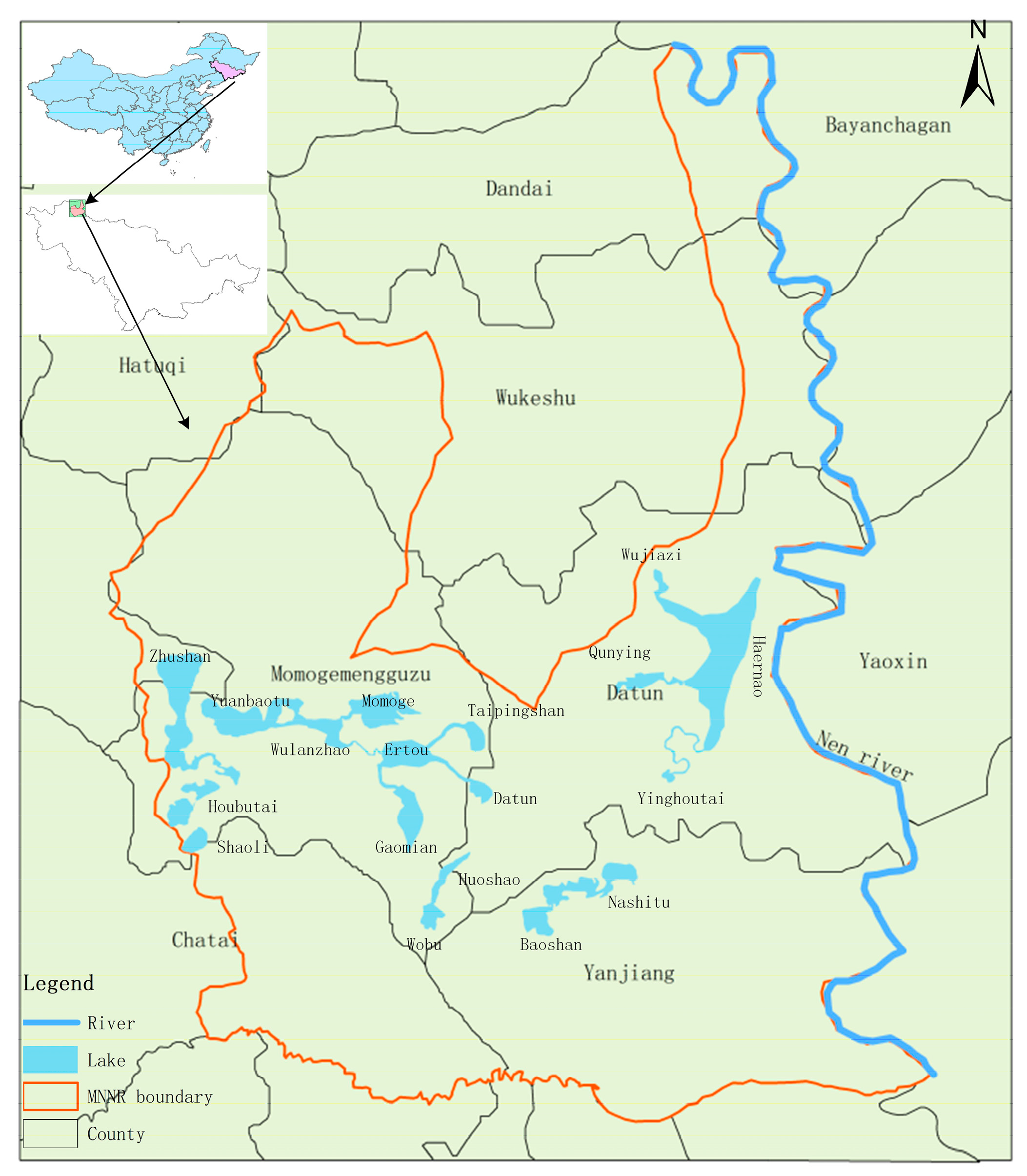
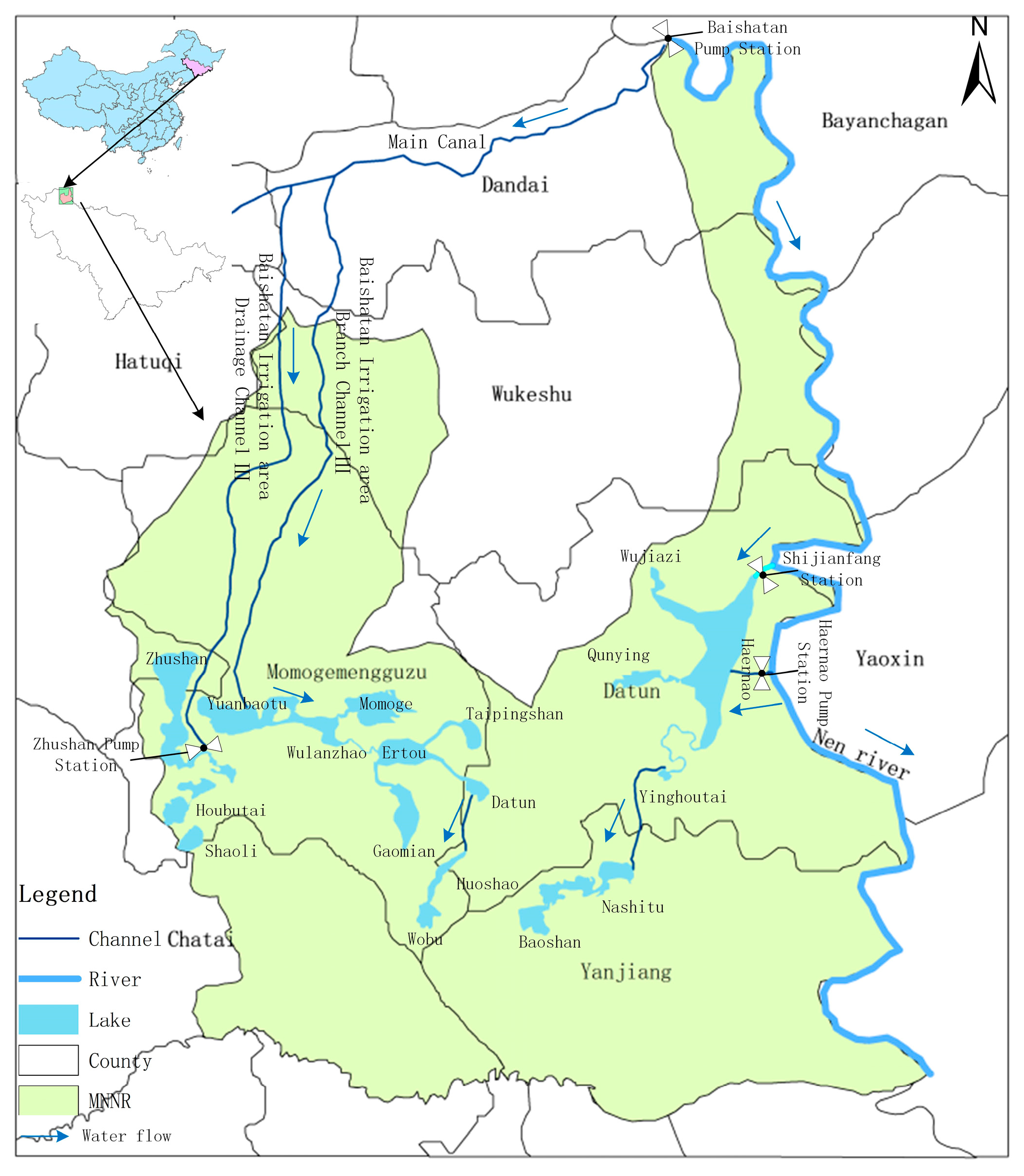
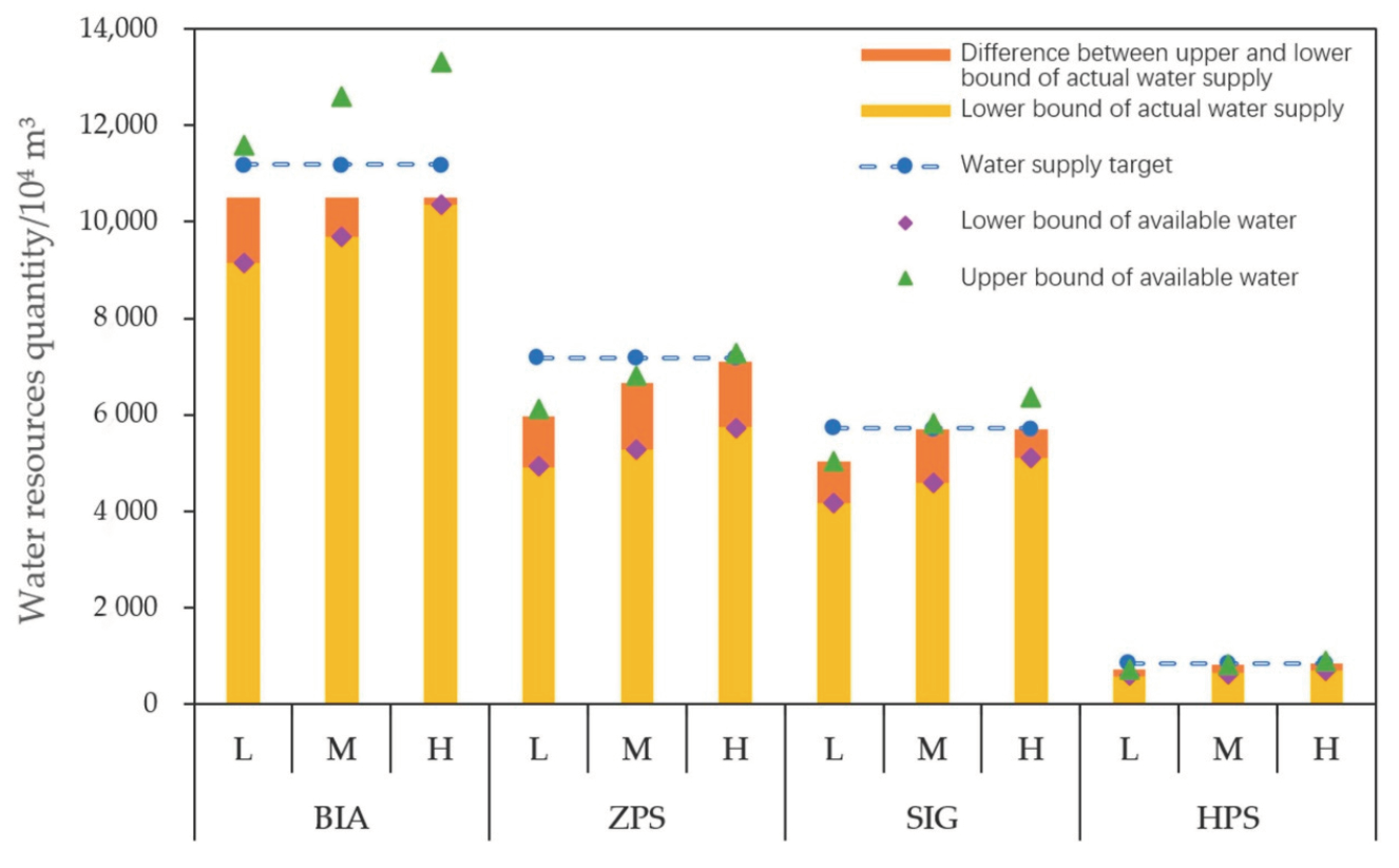

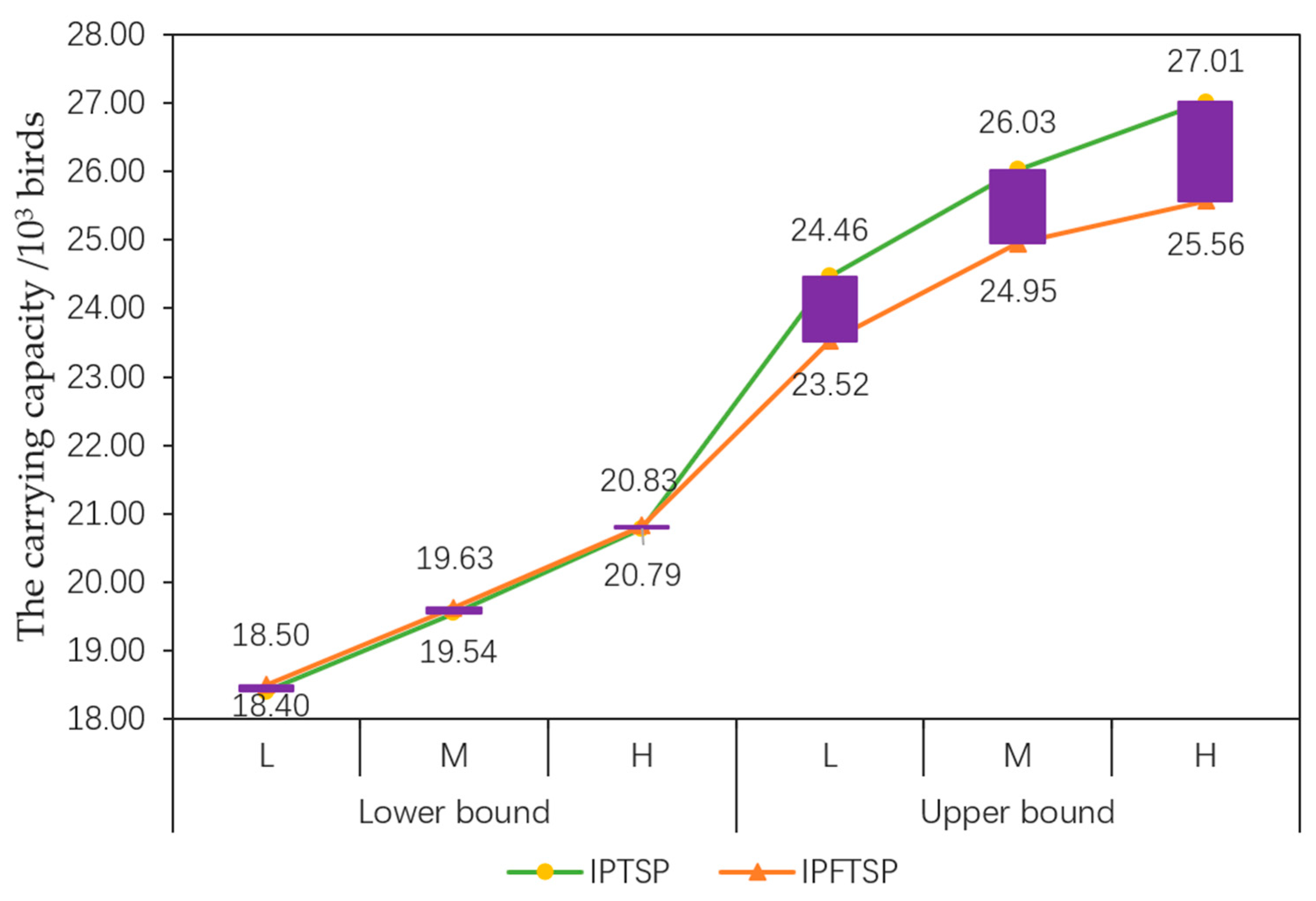
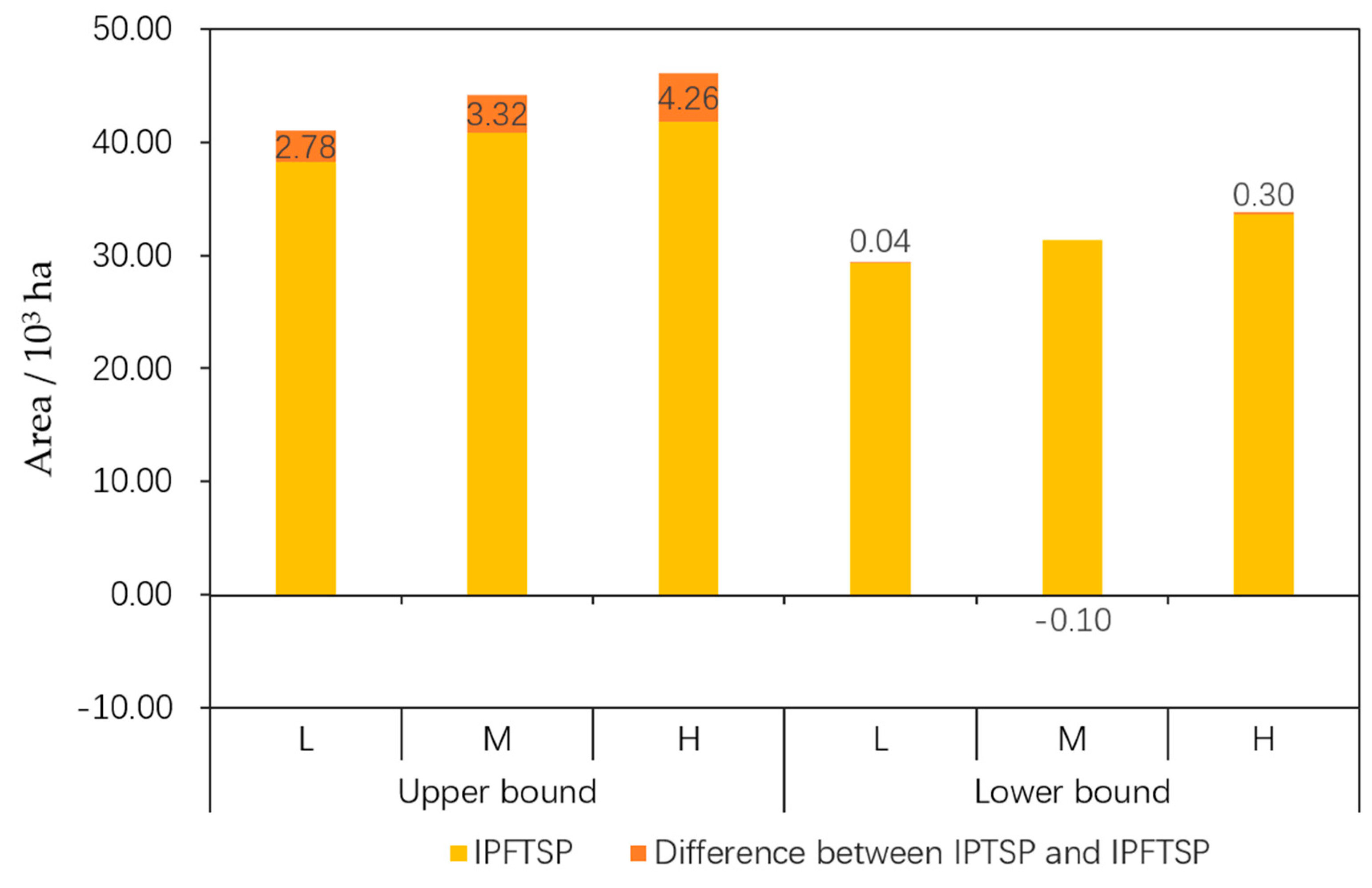
| Intakes | Optimal Water Supply Targets | Local and Normal Water Supply | Flood Resource Supply | ||||
|---|---|---|---|---|---|---|---|
| Low Flow Level | Medium Flow Level | High Flow Level | Low Flow Level | Medium Flow Level | High Flow Level | ||
| BIA | 11,190.23 | (6993.40, 8100.51) | (6993.40, 7066.28) | (6376.80, 6993.40) | (2158.38, 2413.19) | (2697.98, 3447.41) | (3372.47, 4136.90) |
| ZPS | 7181.38 | (3470.05, 4353.25) | (3470.05, 4353.25) | (3470.05, 4332.47) | (1450.66, 1621.91) | (1813.32, 2317.02) | (2266.65, 2780.42) |
| SIG | 5709.35 | (2524.10, 3190.80) | (2524.10, 3049.80) | (2521.49, 2524.10) | (1653.84, 1849.09) | (2067.30, 2641.55) | (2584.13, 3169.86) |
| HPS | 843.85 | (375.65, 489.90) | (375.65, 489.90) | (375.65, 446.41) | (207.36, 231.84) | (259.20, 331.20) | (324.00, 397.44) |
| Total | 24,924.81 | (13,363.20, 16,134.45) | (13,363.20, 14,959.23) | (13,363.20, 13,677.17) | (5470.24, 6116.03) | (6837.80, 8737.18) | (8547.24, 10,484.62) |
| Flood Flow Scenario | Scenario Probability (%) | IPFTSP Model | IPTSP Model | Reduced Scale of Decision Space |
|---|---|---|---|---|
| Low Flow Level | 50.00 | (18,833.44, 22,250.48) | (18,833.44, 23,452.23) | 26.02% |
| Medium Flow Level | 38.00 | (20,201.00, 23,696.41) | (20,201.00, 25,321.47) | 31.74% |
| High Flow Level | 12.00 | (21,910.44, 24,161.79) | (21,910.44, 26,379.43) | 49.62% |
| Regions | Habitat Area of Recommended Scheme | Habitat Area of Optimization Schemes | ||
|---|---|---|---|---|
| Low Flow Level | Medium Flow Level | High Flow Level | ||
| r = 1 | 6.22 | (8.47, 10.17) | (8.81, 10.17) | (9.09, 10.17) |
| r = 2 | 5.95 | (4.41, 6.17) | (4.85, 7.13) | (5.40, 7.60) |
| r = 3 | 0.79 | (0.84, 1.06) | (0.88, 1.14) | (0.94, 1.14) |
| r = 4 | 0.40 | (0.34, 0.47) | (0.38, 0.51) | (0.40, 0.51) |
| Total | 13.36 | (14.06, 17.88) | (14.92, 18.96) | (15.83, 19.43) |
| Target Value | 13.36 | (14.60, 18.47) | ||
| Fuzzy Membership | (0.01, 0.83) | |||
| Flood Flow Scenario | Scenario Probability (%) | Habitat Area in IPFTSP Model | Habitat Area in IPTSP Model | Reduced Scale of Decision Space |
|---|---|---|---|---|
| Low Flow Level | 50.00 | (14.06, 17.88) | (13.99, 18.59) | 17.15% |
| Medium Flow Level | 38.00 | (14.92, 18.96) | (14.85, 19.78) | 17.98% |
| High Flow Level | 12.00 | (15.83, 19.43) | (15.80, 20.53) | 23.86% |
| Target value | (14.60, 18.47) | (14.53, 19.28) | 18.28% |
| Ecological Function Regions | Area of Ecological Function Region by Recommended Scheme | Area of Ecological Function Region by Optimal Schemes | ||
|---|---|---|---|---|
| Low Flow Level | Medium Flow Level | High Flow Level | ||
| Fish Pond | 3.29 | (2.63, 3.15) | (2.63, 3.78) | (3.46, 3.78) |
| Crab Pond | 6.53 | (5.50, 8.60) | (7.86, 8.73) | (8.65, 8.73) |
| Reed Wetland | 7.44 | (7.59, 8.62) | (7.01, 8.94) | (7.88, 8.95) |
| Marsh Wetland | 16.98 | (13.58, 17.86) | (13.81, 19.37) | (13.58, 20.31) |
| Total Area | 34.23 | (29.31, 38.23) | (31.31, 40.82) | (33.57, 41.78) |
| Flood Flow Scenario | Scenario Probability (%) | Total Recovered Area in IPFTSP Model | Total Recovered Area in IPTSP Model | Interval Width Reduction Ratio |
|---|---|---|---|---|
| Low Flow Level | 50.00 | (29.31, 38.23) | (29.35, 41.01) | 23.52% |
| Medium Flow Level | 38.00 | (31.31, 40.82) | (31.21, 44.14) | 26.48% |
| High Flow Level | 12.00 | (33.57, 41.78) | (33.88, 46.04) | 32.54% |
| Recommended Scheme | IPFTSP Model | IPTSP Model | Interval Width Reduction Ratio | |
|---|---|---|---|---|
| Ecological Service Value (in 108 CNY) | ||||
| Low Flow Level | 29.23 | (25.07, 39.51) | (25.22, 41.89) | 13.39% |
| Medium Flow Level | (27.18, 42.09) | (27.01, 44.89) | 16.59% | |
| High Flow Level | (29.31, 42.99) | (29.25, 46.76) | 21.86% | |
| Net Carbon Sink (in 104 t) | ||||
| Low Flow Level | 3.80 | (3.34, 5.19) | (3.12, 5.33) | 16.41% |
| Medium Flow Level | (3.14, 5.42) | (3.37, 6.34) | 23.14% | |
| High Flow Level | (3.45, 5.48) | (3.77, 6.60) | 28.08% |
Publisher’s Note: MDPI stays neutral with regard to jurisdictional claims in published maps and institutional affiliations. |
© 2020 by the authors. Licensee MDPI, Basel, Switzerland. This article is an open access article distributed under the terms and conditions of the Creative Commons Attribution (CC BY) license (http://creativecommons.org/licenses/by/4.0/).
Share and Cite
Liao, X.; Meng, C.; Ren, Z.; Zhao, W. Optimization of Ecological Water Supplement Scheme for Improved Suitable Habitat Area for Rare Migratory Birds in Nature Reserves Using Interval-Parameter Fuzzy Two-Stage Stochastic Programming Model. Int. J. Environ. Res. Public Health 2020, 17, 7562. https://doi.org/10.3390/ijerph17207562
Liao X, Meng C, Ren Z, Zhao W. Optimization of Ecological Water Supplement Scheme for Improved Suitable Habitat Area for Rare Migratory Birds in Nature Reserves Using Interval-Parameter Fuzzy Two-Stage Stochastic Programming Model. International Journal of Environmental Research and Public Health. 2020; 17(20):7562. https://doi.org/10.3390/ijerph17207562
Chicago/Turabian StyleLiao, Xianrui, Chong Meng, Zhixing Ren, and Wenjin Zhao. 2020. "Optimization of Ecological Water Supplement Scheme for Improved Suitable Habitat Area for Rare Migratory Birds in Nature Reserves Using Interval-Parameter Fuzzy Two-Stage Stochastic Programming Model" International Journal of Environmental Research and Public Health 17, no. 20: 7562. https://doi.org/10.3390/ijerph17207562
APA StyleLiao, X., Meng, C., Ren, Z., & Zhao, W. (2020). Optimization of Ecological Water Supplement Scheme for Improved Suitable Habitat Area for Rare Migratory Birds in Nature Reserves Using Interval-Parameter Fuzzy Two-Stage Stochastic Programming Model. International Journal of Environmental Research and Public Health, 17(20), 7562. https://doi.org/10.3390/ijerph17207562




